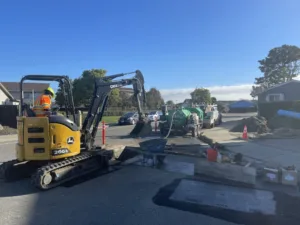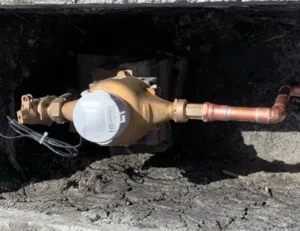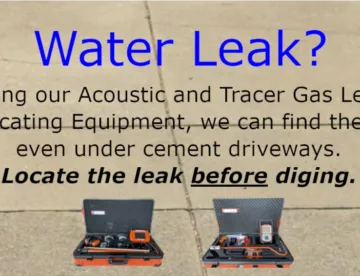If you need to upgrade or add new water service, you will usually need to hire an A-General Engineering Licensed contractor such as Freedom Underground. Only a General Engineering license holder can work on public assets (aka Public Works) such as a city-owned street or sidewalk. You will also work with your water utility.
Major Steps in a new water line Project to upgrade your water service
- Hire a A-General Engineering Licensed contractor such as Freedom Underground.
- Obtain the required permits from the Water Utility Provider, the local Public Works Department of your City or County depending on who maintains the sidewalk and street, and often a City building department. Freedom Underground will do this for you as part of your project.
- Underground Service Alert, aka USA 811
Permits and Approvals
Installing a new water service line involves your Water Utility Provider, your City or County’s Public Works department, and often the building department of the City or County where the property is located. The permits with the Public Works department are often called “Encroachment Permits” and are more complex to file for and obtain then a building permit. Encroachment Permits will often require specific insurances from the contractor, sometimes a bond, site construction plans and traffic control plans.
Freedom Underground has done hundreds of these types of projects in the various communities of the Bay Area and will file for and manage this process for you. While a building permit can often be obtained in a few days or less, an encroachment permit will usually take 4+ weeks from the moment we start the process.
Underground Service Alert, a.k.a. USA 811
Before digging, we create a USA 811 ticket which triggers local utilities with underground lines in the area to come out and mark their lines. This service greatly reduces any chance we accidentally hit an existing utility line.
Pre-Construction meeting with the Public works inspector
With permits in hand, a “pre-con” meeting with the utility and the City/County is scheduled to meet at the project site. At these pre-con meetings, we will discuss the specifics of the project and gain approval from the inspectors to start.
Excavation
The first major construction step is excavating the street.

- In some cases, we need to post notices of pending construction. These will usually be done 48 hours or more in advance.
- When we arrive, we first deploy traffic control signs, cones, etc per the approved Traffic Control Plan. Once safe, we cut the asphalt and can begin excavation. Sometimes, we will come and cut the asphalt before the day we start the actual excavation. The street is still safe to drive on.
- With excavation underway, we will dig until we expose the main water line in the street. We use a variety of tools depending on the situation such as the soil and potential for existing utility lines in the area. You will very likely see one of our excavators on site. Even for a job where the excavator is not being used for digging, we need it to move the heavy traffic plates that we use to cover the trenches while we are not onsite.
- When we are not actively doing construction, the trench will be covered using these heavy, traffic-rated plates and cold patch asphalt. The plates allow the street to be used by cars.
- Once the trench is exposed, we can install the pipe specified in the project. The meter end of the pipe will have an angle stop (an angled shutoff valve) while the water supply side will be left open to attach to a ball corp or other valve designed to work with the specified clamping device that will be used for hot tapping.
Connecting to the Water Main
Connecting to the water main is done either by cutting the water main and making a connection or, most commonly, via Hot Tapping. Hot Tapping is a technique that allows the creation of a new connection to an existing, pressurized water line without cutting it and disrupting water flow to the neighborhood.
If Hot Tapping…
- When hot tapping, we attach a clamping device called a saddle or tapping sleeve as well as a matching valve that will allow a “tap” into a pressurized water line. The process is a safe and economical way to add new service lines without interrupting the water service.
- Either the water utility or a tapping specialist will perform the actual tap. Freedom Underground will prepare the area and install all the required parts.
If cutting the main…
- The Water Utility will schedule their crew to shut off water supply to the area.
- The Utility or, more likely, Freedom Underground will distribute advanced notices to impacted homes.
- On the day of the shut off, the Water Utility will turn the water off, then open a nearby fire hydrant so that water can drain from the area.
- Once enough water has been drained out, the water main will be cut and a new connection point installed.

This is a picture of a saddle, ball corp, and a new 1″ HDPE Pipe with a tracer wire. The saddle and ball corp are installed before the tap. Once the hot tap is completed, the pipe will be attached.
During the hot tap, the saddle, ball corp, and tapping machine work together to control the pressurized water. After the tap, the ball corp (which is a type of valve) controls the water until the meter is installed at the other end of the pipe.
Backfill and final Connections

- With the hot tap completed, we need to connect it to the water meter. If a new water meter is required, which is usually the case, it is installed in an approved enclosure box, such as a Christy B16, along with the required fittings. In some cases, Freedom Underground will source and install the meter and in other cases, the water utility takes that responsibility.
- Once the meter is connected, your new water line is in service.

